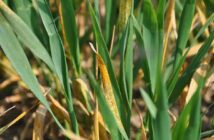Delayed drilling of some spring cereal crops due to wet soil conditions will result in later emerging seedlings being more susceptible to effects of Barley Yellow Dwarf Virus (BYDV) infection, compounded by high numbers of winged aphids on the move.
Aphids that are already carrying the virus, picked up from infected crops over the mild winter, can rapidly transmit BYDV – with younger plants more susceptible to infection and potential to suffer greater losses, warns Syngenta Technical Manager, Pete Saunders. After prolonged aphid activity through the autumn, the level of infection sources for transmission this spring is predicted to be high.
Pete advocated the fast knock-down action of Hallmark Zeon is essential to minimise the virus transmission to newly emerged spring cereal crops, plus its proven repellent activity can help to reduce the threat of aphid migration into the crop. “Seeking to keep initial infection of BYDV out of the crop is crucial to prevent hot-spots of disease, which could be rapidly spread by further aphid feeding activity,” he advised.
When targeting small leaves on young plants, Pete highlighted the microencapsulation of Hallmark Zeon, with its physically greater number of nano-capsules containing the active ingredient, can achieve greater coverage of the leaf surface. Furthermore, he points out that as capsules retained on the leaf rupture with insect movement to release more active, it can deliver greater persistence of aphid control.
Results of aphid monitoring have already highlighted the large numbers of aphids ready to migrate after the relatively mild winter – including the Bird Cherry Aphid and Grain Aphid most closely associated with BYDV transmission. Adult Grain Aphids and young nymphs could be readily found on all wheat varieties at the Syngenta Innovation Centre in Oxford during March, for example, reported trialist, Tom Clarke.
Whilst Storm Katie’s wet and windy weather may have checked movement over the Easter weekend, he anticipated the sheer numbers of aphid present in crops and surrounding fields would be likely to trigger new flushes during every mild and settled period.
Once a cereal plant is infected with BYDV, as the pathogen rapidly multiplies it saps the energy of plants – which leads to the symptomatic yellowing of leaves and weak growth. Small plants, without the photosynthetic potential to respond, can suffer the greatest losses. The relatively short growing season of spring crops means they can be particularly badly hit, especially if rooting is reduced and crops are then affected by drought or other stresses.
Pete Saunders advises: “With the predictions of an especially difficult season for aphid control, growers and agronomists will need to be ready for Hallmark Zeon treatments at the full robust rate of 50 ml/ha to minimise the risk of BYDV spread.”



